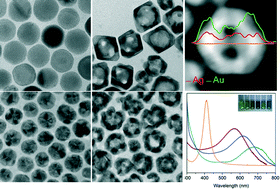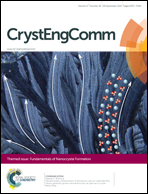Controlling alloy formation and optical properties by galvanic replacement of sub-20 nm silver nanoparticles in organic media†
Abstract
Galvanic replacement is a versatile synthetic strategy for the synthesis of alloy and hollow nanostructures. The structural evolution of single crystalline and multiply twinned nanoparticles <20 nm in diameter and capped with oleylamine is systematically studied. Changes in chemical composition are dependent on the size and crystallinity of the parent nanoparticle. The effects of reaction temperature and rate of precursor addition are also investigated. Galvanic replacement of single crystal spherical and truncated cubic nanoparticles follows the same mechanism to form hollow octahedral nanoparticles, a mechanism which is not observed for galvanic replacement of Ag templates in aqueous systems. Multiply twinned nanoparticles can form nanorings or solid alloys by manipulating the reaction conditions. Oleylamine-capped Ag nanoparticles are highly adaptable templates to synthesize a range of hollow and alloy nanostructures with tuneable localised surface plasmon resonance.

- This article is part of the themed collection: Fundamentals of Nanocrystal Formation

 Please wait while we load your content...
Please wait while we load your content...